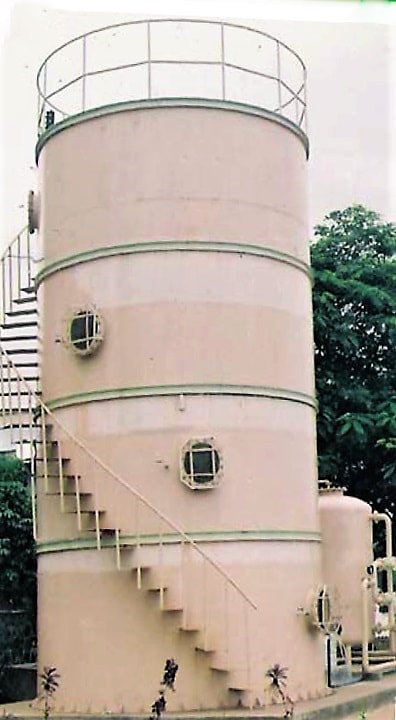Effwa’s R&D team has conquered an engineering challenge by developing a process which accomplishes anaerobic, aerobic and anoxic treatment within a single reactor, to yield consistent quality treated sewage conforming to the discharge standards of CPCB, which can then be treated further for reuse. We present the most advanced engineering solution for sewage treatment, AnBioCell (patent pending).
Wastewater Treatment Process Description
1: Anaerobic Zone with Sludge Blanket; 2: Aerobic Zone with suspended substrate; 3: Anoxic Zone; 4: Tube Deck
The raw sewage received in the inlet chamber undergoes coarse screening followed by oil and grease removal (in oil and grease trap) before it enters the AnBioCell reactor. The raw sewage after pre-treatment is either pumped or under gravity enters the AnBioCell reactor which is based on Hybrid-Fixed-Film process accomplishing anaerobic, aerobic and anoxic conditions in up-flow sequence to deliver high quality treated sewage for use in gardening or safe disposal.
The feed enters the bottom-most anaerobic zone of AnBioCell well distributed across the section of the reactor through distribution grid and flows upward through sludge blanket (as in case of conventional UASB) before reaching the suspended film zone (PVDF woven rope media housing multifold bioculture). Just above the semi- suspended zone liquid- biogas separator is placed to serve as transitional curtain between anaerobic and upper aerobic zones as also to collect the Biogas as by-product for safe diposal or reuse.
The aerobic zone with similar semi suspended substrate made of PVDF has air supply underneath to maintain aerobic culture. The air grid is so designed with fine bubble diffusers to protect the substrate against excessive scouring. The excess air supplied and the resulting carbon dioxide as an end product from the aerobic zone find its way out separately through Liquid-Gas separator to atmosphere.
After the separation of liquid and gases above aerobic zone, the sewage flows upward across the section of reactor through Anoxic Zone where same substrate media is provided. The Tube Deck (TD) at top zone retains scoured bio-films within the reactor and allows supernatant to over flow. The supernatant quality from the system meets far higher quality standards than with alternative systems. The biofilms as sludge is drained periodically and dewatered using Filter Press / Belt Press / Centrifuge.
The tertiary treatment of outlet from AnBioCell comprising of online disinfection, filtration through Graded Filtration and Coalescing Columns (GFCC) and polishing through Adsorption Column delivers the output which could be reused for flushing, fire fighting, etc.
Treated Sewage Characteristics
Considering the typical characteristics of raw sewage presented in the table below, typically there is a need to reduce the TSS, oil and grease, BOD, COD, TKN, TDS and Total coliform to meet standards for discharge into Inland surface water. Also, there is a need to increase the dissolved oxygen concentration to conform with the treated sewage discharge standards.
Typical characteristics of raw sewage
pH :
6 to 8
Total Suspended solids (TSS) :
150 to 400 mg/L
Oil & Grease :
10 to 20 mg/L
BOD5 :
150 to 300 mg/L
COD :
450 to 650 mg/L
TKN :
50 to 100 mg/L
Total Dissolved Solids (TDS) :
600 to 1200 mg/L
Total coliform (MPN/100 mL) :
107 to 109
Dissolved Oxygen :
Nil to 1 mg/L
The treated sewage at the outlet of the AnBioCell typically has pH in the range of 7 to 7.5, TSS < 30 mg/L, oil and grease < 10 mg/L, BOD5 in the range 15 to 20 mg/L, Chemical Oxygen Demand (COD) in the range 75 to 110 mg/L and Total Kjedahl Nitrogen (TKN) in the range 20 to 30 mg/L. The dissolved oxygen concentration is also increased to 4 to 5 mg/L, which conforms to the discharge standards. However, it is required to reduce the total coliforms (<100 mg/L) and TDS (600 to 1200 mg/L) further, for which downstream tertiary treatment must be provided, followed by ultrafiltration. Reverse osmosis system may also be provided after Ultrafiltration for further polishing. The characteristics of sewage achieved at the end of the treatment chain including downstream tertiary treatment, UF and RO system is tabulated hereunder, which is also suitable for reuse.
Typical treated sewage characteristics
pH :
7 to 7.5
Total Suspended solids (TSS) :
Nil
Oil & Grease :
Nil
BOD5 :
Nil
COD :
< 5 mg/L
TKN :
Nil
Total Dissolved Solids (TDS) :
< 100 mg/L
Total coliform (MPN/100 mL) :
Nil
Dissolved Oxygen :
4 to 5 mg/L
Advantages of the AnBioCell System for Wastewater Treatment

Minimum civil works

Quick construction and commissioning

Lower footprint (70% area saving)

Construction in non-corrosive alloy

Fully underground/ above ground construction possible

Modular construction and ease in expansion

Aesthetically pleasant plant

Consistent and high quality treated effluent

Low power consumption (30 to 50 % savings)

Odourless operation

Low excess sludge production

Fully digested sludge available as manure

Nutrient removal

Pre-engineered systems available for small capacities

Simple and economical to operate
After having earned the James Berkley Gold medal for her excellence in Civil Engineering from the University of Mumbai and completion of M. Tech. in Environmental Engineering from Indian Institute of Technology Guwahati, Shravani now works with team Effwa towards solution formulation for various complex environmental issues of the 21st century.




